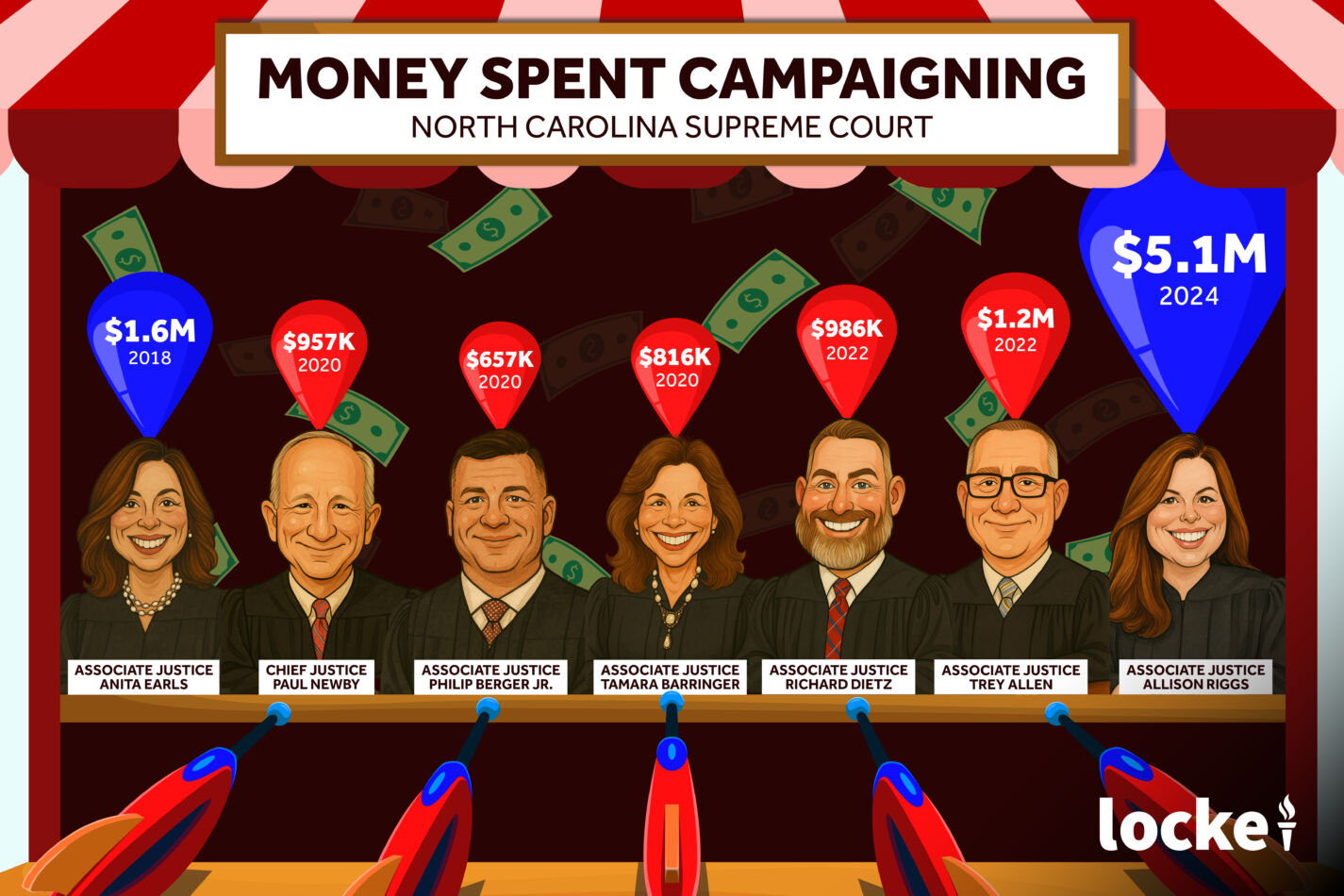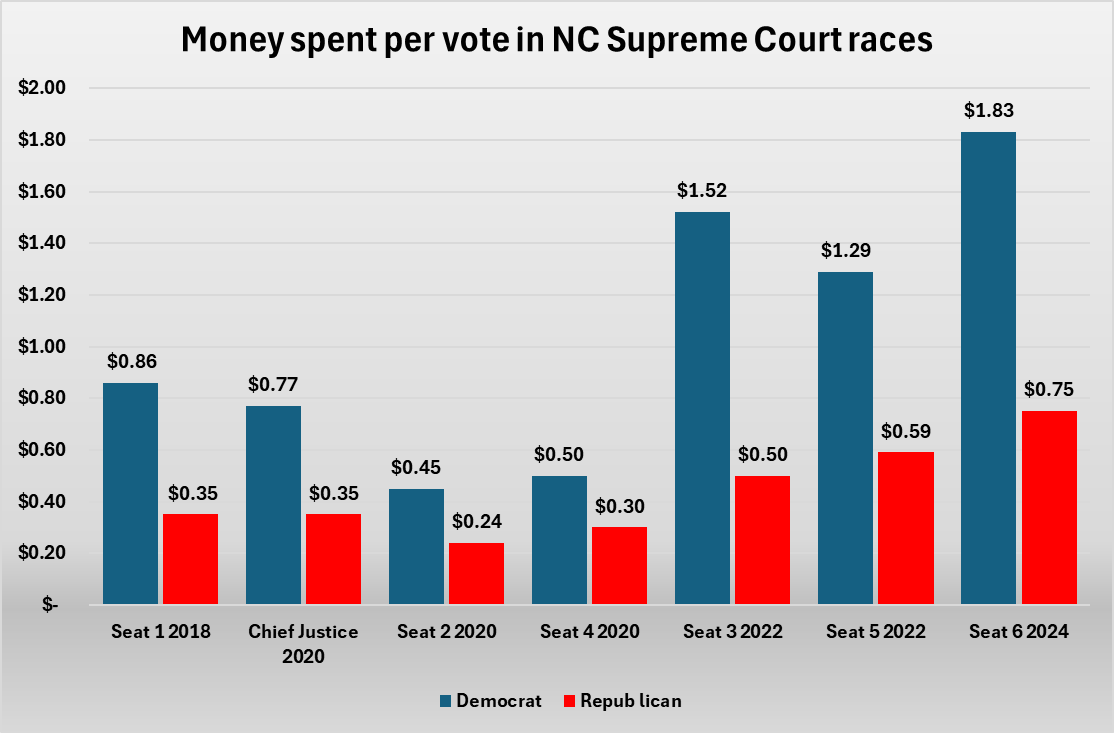The State Board of Elections (SBE) has released the mid-year semi-annual campaign finance reports from the two presumptive major party candidates for the 2026 North Carolina Supreme Court race, incumbent Democrat Anita Earls and Republican challenger state Rep. Sarah Stevens.
Earls is well ahead of Stevens in the money race
According to the SBE, Earls raised $581,227.26 in the first half of 2025 and has $481,526.54 cash on hand. By comparison, Stevens raised $140,980.18 and has $156,222.01 cash on hand. Earls spent $117,237.41 during that period, compared to Stevens’ $14,499.23.
Earls’ total includes $17,536.69 she had on hand at the beginning of the year, while Stevens’ total includes $29,741.06 she rolled over from her state legislative committee.
While Earls starts with a commanding money lead, Stevens’ supporters have no reason to panic, at least not yet, for two reasons.
First, while Earls is a seven-year incumbent who actively raised money over the entire reporting period, Stevens only announced her candidacy in May and did not receive her first donation until May 12. Earls raised $303,159.55 from May 12 to the end of the reporting period. That is still more than twice as much as Stevens raised, and Earls will almost certainly continue to outraise Stevens, but Stevens is raising enough to stay competitive.
Democrats have had to spend more than twice as much to win
Why can Stevens stay competitive when raising about half of what Earls raises?
That is what recent history has shown.
As seen in the graphic below, since Supreme Court seats reverted to being elected on a partisan basis in 2018, Republicans have had to spend less money, sometimes considerably less, to win. Earls’ $1.6 million spent in 2018 was unsurpassed by any winning candidate until Allison Riggs blew past it by spending $5.1 million in 2024.

Not only that, win or lose, Democrats have outspent Republicans in every one of the seven Supreme Court races since 2018 (see the table below). Spending totals came from total expenditures in fourth-quarter reports filed with the SBE. Vote totals are also from SBE data.
| Candidate | Votes | Spending | Spending per vote |
| 2018 Associate Justice Seat 1 | |||
| Anita Earls (D) | 1,812,751 (49.6%) | $1,553,527.35 | $0.86 |
| Barbara Jackson (R) | 1,246,263 (34.1%) | $431,679.49 | $0.35 |
| Chris Anglin (R)* | 598,753 (16.4%) | $20,053.47 | $0.03 |
| 2020 Chief Justice | |||
| Paul Newby (R) | 2,695,951 (50.0%) | $956,961.82 | $0.35 |
| Cheri Beasley (D) | 2,695,550 (50.0%) | $2,066,280.20 | $0.77 |
| 2020 Associate Justice Seat 2 | |||
| Phil Berger, Jr. (R) | 2,723,704 (50.7%) | $657,148.37 | $0.24 |
| Lucy Inman (D) | 2,652,187 (49.3%) | $1,202,364.91 | $0.45 |
| 2020 Associate Justice Seat 4 | |||
| Tamara Barringer (R) | 2,746,362 (51.2%) | $816,112.95 | $0.30 |
| Mark Davis (D) | 2,616,265 (48.8%) | $1,298,899.17 | $0.50 |
| 2022 Associate Justice Seat 3 | |||
| Richard Dietz (R) | 1,965,840 (52.4%) | $986,214.00 | $0.50 |
| Lucy Inman (D) | 1,786,650 (47.6%) | $2,719,882.35 | $1.52 |
| 2022 Associate Justice Seat 5 | |||
| Trey Allen (R) | 1,957,440 (52.2%) | $1,163,860.24 | $0.59 |
| Sam J. Ervin IV (D) | 1,792,873 (47.8%) | $2,316,187.50 | $1.29 |
| 2024 Associate Justice Seat 6 | |||
| Allison Riggs (D) | 2,770,412 (50.0%) | $5,059,595.06 | $1.83 |
| Jefferson G. Griffin (R) | 2,769,678 (50.0%) | $2,090,823.01 | $0.75 |
Earls spent more than three times incumbent Barbara Jackson’s total. In almost every other race, the Democrat, win or lose, spent about twice or more than the Republican. The only exception was the 2020 Associate Justice Seat 4 race, in which Democrat Mark Davis only spent about 1.5 times what Republican Tamara Barringer spent. If money is the most important factor in winning votes, Democratic Supreme Court candidates have been egregiously underperforming.
If money is the most important factor in winning votes, Democratic Supreme Court candidates have been egregiously underperforming
Another way to look at the data is dollars spent per vote. As seen in the graphic below, Democrats have spent more per vote than Republicans in races for every seat on the court. While Republican Jefferson Griffin almost spent as much per vote in 2024 as Earls did in 2018, he was still outspent per vote by Riggs by more than 2-to-1.

But was Griffin able to keep the race so close because he benefited from more outside spending?
No. RIggs benefited from more than fifteen times the amount of independent expenditures spent on her behalf than Griffin did:
Independent expenditures (IEs) were another area where Riggs outpaced Griffin. She received $3.3 million in IEs, while Griffin garnered approximately $213,000. IEs are not subject to contribution limits but must adhere to reporting requirements.
Of course, there is more to winning elections than money. Factors such as candidate quality and the political environment also help. Earls benefited from running in a Republican presidential midterm election and from a nominally Republican spoiler candidate in 2018. While she will not have a spoiler candidate to help her this time around, she is once again running in a midterm election (in which the president’s party tends to suffer losses).
So, we can expect Anita Earls to raise a lot more money than Sarah Stevens will in the 2026 North Carolina Supreme Court race. But, unless she raises at least 2.5 times as much, it might not be enough.











